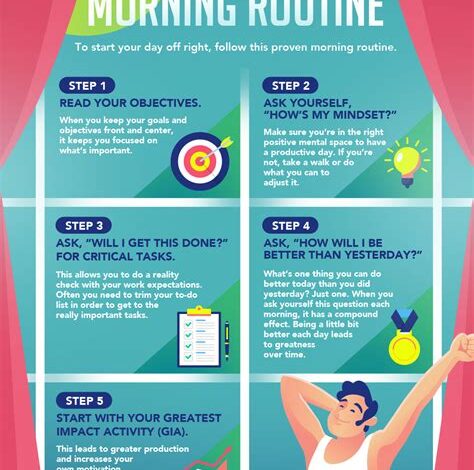How to Build a Productive Morning Routine

Want to know how to build a productive morning routine? This blog post explores the importance of starting your day intentionally and provides a practical guide to crafting a personalized schedule. We begin by understanding why a morning routine is crucial for productivity and then guide you through identifying your personal productivity goals. Learn how to create a schedule that seamlessly fits your lifestyle and discover actionable steps to sustain your new habits long-term. Implement these strategies to transform your mornings and set yourself up for a successful day.
Understanding The Importance Of A Morning Routine
Establishing a solid morning routine is more than just a trendy habit; it’s a foundational element for a productive and fulfilling day. A well-structured morning sets the tone, allowing you to approach tasks with clarity and intention. By dedicating time to activities that energize and focus you, you’re better equipped to handle the challenges and opportunities that lie ahead. Learning how to build a productive morning routine can significantly impact your overall well-being and success.
One of the key benefits of a consistent morning routine is its ability to reduce stress and anxiety. Starting the day in a controlled and deliberate manner can minimize the feeling of being overwhelmed. When you have a plan in place, you’re less likely to feel rushed or scattered. This proactive approach creates a sense of calm and control, enabling you to navigate your day with greater ease and resilience.
| Component | Description | Benefit |
|---|---|---|
| Meditation | Mindfulness practice to center your thoughts. | Reduces stress and increases focus. |
| Exercise | Physical activity to energize your body. | Improves mood and boosts energy levels. |
| Planning | Reviewing your schedule and prioritizing tasks. | Enhances organization and reduces overwhelm. |
| Healthy Breakfast | Nourishing your body with essential nutrients. | Provides sustained energy throughout the morning. |
A productive morning routine also fosters better time management. By allocating specific slots for important activities, you’re less prone to procrastination and more likely to accomplish your goals. This structured approach helps you prioritize tasks effectively and allocate your time where it matters most. Furthermore, it allows you to build momentum early in the day, setting you up for sustained productivity.
Ultimately, investing in a well-designed morning routine is an investment in yourself. It’s about carving out time for activities that nurture your mind, body, and spirit. When you prioritize self-care and intentionality from the moment you wake up, you create a ripple effect that positively impacts every aspect of your life. This consistent practice can lead to increased productivity, improved well-being, and a greater sense of fulfillment.
- Benefits of a Productive Morning Routine:
- Enhanced Focus and Clarity
- Reduced Stress and Anxiety
- Improved Time Management
- Increased Energy Levels
- Better Overall Well-being
How To Identify Your Personal Productivity Goals
To effectively build a productive morning routine, understanding and identifying your personal productivity goals is paramount. Without clear goals, your efforts might lack direction, leading to inefficiency and frustration. Identifying these goals involves a deep dive into your current habits, desired outcomes, and key activities. This self-assessment process will help you tailor your routine to address what truly matters to you, making it more effective and sustainable. Remember, the most productive routines are those that align with your individual aspirations and priorities. In this section, we’ll explore how to pinpoint your specific goals to create a morning routine that truly works for you. The main goal is to understand how to strategically align daily activities with broader objectives.
Before diving into specific strategies, it’s crucial to acknowledge the gap between where you are and where you want to be. Setting productivity goals isn’t just about doing more; it’s about doing the right things more effectively. Consider what areas of your life or work could benefit most from a productivity boost. Is it finishing projects on time? Reducing stress? Having more time for personal development? Answering these questions forms the foundation of your goal-setting process. The goal-setting process may seem daunting at first. This is why we will be going through each step of the process carefully to reach the most accurate results.
Assessing Current Habits
Begin by honestly evaluating your current morning routine, or lack thereof. What activities do you typically engage in? How much time do you spend on each? Are these activities contributing to your overall well-being and productivity, or are they draining your energy and focus? Keeping a detailed log for a few days can provide valuable insights. Analyze your routine for time-wasting habits and identify areas where improvements can be made. Once the problem areas have been found, it is time to move on to the next step.
After reviewing your current habits, it’s time to document your findings. You can use the table below.
| Time | Activity | Productivity Level (1-10) | Notes |
|---|---|---|---|
| 7:00 AM – 7:30 AM | Snoozing Alarm/Checking Phone | 2 | Feel more tired after snoozing. Social media is distracting. |
| 7:30 AM – 8:00 AM | Getting Ready | 6 | Routine is rushed and stressful. |
| 8:00 AM – 8:30 AM | Commute | 4 | Traffic is frustrating; could listen to podcasts. |
| 8:30 AM – 9:00 AM | Checking Emails | 5 | Respond to urgent emails, but gets sidetracked. |
Defining Desired Outcomes
What do you want to achieve with a more productive morning routine? Defining your desired outcomes is crucial for setting meaningful goals. These outcomes should be specific, measurable, achievable, relevant, and time-bound (SMART). Instead of vaguely aiming to be more productive, set a goal like complete the first draft of a report by 10:00 AM every workday. Clear outcomes provide a target to aim for and make it easier to track your progress. This way it will be much easier how to measure your progress.
Once you know the desired outcomes, you can define your goals:
- Identify Key Result Areas: Determine the areas in your life where productivity gains will have the most significant impact.
- Set SMART Goals: Define specific, measurable, achievable, relevant, and time-bound goals for each key area.
- Write Down Your Goals: Make your goals tangible by writing them down and keeping them visible.
- Visualize Success: Imagine achieving your goals and how it will positively impact your life.
- Break Down Large Goals: Divide larger goals into smaller, manageable tasks that can be tackled daily.
Prioritizing Key Activities
Not all activities are created equal. Some tasks have a far greater impact on your goals than others. Prioritizing key activities means identifying the tasks that will move you closest to your desired outcomes and focusing on those first thing in the morning. This might involve working on a high-priority project, engaging in focused learning, or exercising to boost your energy levels. By tackling the most important tasks when you’re fresh and alert, you set the tone for a productive day. If you prioritize key activities, it becomes easier how to decide which one is more important.
In conclusion, identifying your personal productivity goals is a foundational step in building an effective morning routine. By assessing your current habits, defining desired outcomes, and prioritizing key activities, you can create a routine that is tailored to your specific needs and aspirations. Remember, the goal is to create a routine that supports your overall well-being and helps you achieve your most important goals. When crafting your goals, keep this in mind:
The key is not to prioritize what’s on your schedule, but to schedule your priorities. – Stephen Covey
Crafting A Schedule That Suits Your Lifestyle
Creating a morning routine that sticks means tailoring it to how to fit seamlessly into your daily life. Consider your natural rhythms, energy levels, and existing commitments. Are you a night owl trying to force yourself into an early bird? Or do you thrive in the quiet hours before the world wakes up? A realistic schedule acknowledges your personal preferences and constraints, making it more likely you’ll adhere to it long-term.
- Assess Your Current Morning: Note what you already do and how long it takes.
- Identify Time Blocks: Allocate specific times for each activity.
- Prioritize Key Activities: Focus on the most impactful tasks first.
- Build in Buffer Time: Account for unexpected delays or adjustments.
- Be Flexible: Allow for changes on weekends or special occasions.
One of the keys to a sustainable morning routine is to ensure it aligns with your overall goals and responsibilities. It’s not just about filling time; it’s about enhancing your well-being and productivity in a way that complements the rest of your day. The following table can help you in tailoring a morning routine that suits your lifestyle:
| Time | Activity | Duration |
|---|---|---|
| 6:00 AM | Wake up, drink water | 10 minutes |
| 6:10 AM | Light exercise/Yoga | 20 minutes |
| 6:30 AM | Meditation/Mindfulness | 10 minutes |
| 6:40 AM | Breakfast & Plan the day | 20 minutes |
Remember, the best morning routine is one you can consistently maintain. Start small and gradually add more elements as you become more comfortable. It’s okay to experiment and tweak your schedule until you find the perfect fit.
Finally, don’t be afraid to reassess your routine periodically. As your life changes, so too should your morning schedule. Regularly evaluate what’s working and what’s not, and adjust accordingly to ensure your routine remains a valuable and sustainable part of your day.
Okay, I will create the content section according to your specifications, focusing on SEO optimization and readability. html
Actionable Steps For Sustaining Your New Habits
Sustaining a new morning routine requires more than just initial enthusiasm; it demands a structured approach to reinforce the habit over time. Integrating your routine into your daily life involves consistent effort and adjustments. The key is to make the routine adaptable to your changing needs and circumstances, ensuring it remains a valuable part of your day. Remember that building a productive morning routine is a journey, not a destination, and continuous refinement is part of the process of learning how to enhance your productivity.
| Step | Description | Frequency |
|---|---|---|
| Review & Adjust | Assess the effectiveness of your routine and make necessary changes. | Weekly/Monthly |
| Prepare the Night Before | Lay out clothes, prepare breakfast items, and organize your workspace. | Daily |
| Track Your Progress | Use a journal or app to monitor your adherence to the routine. | Daily |
| Reward Yourself | Acknowledge your consistency with small, healthy rewards. | Weekly |
One of the most effective ways to ensure your morning routine sticks is to link it with existing habits. This technique, known as habit stacking, involves adding your new routine elements to actions you already perform automatically. For example, if you always make coffee in the morning, you could do a five-minute meditation session while the coffee is brewing. This connection makes it easier to remember and integrate the new habit into your daily life.
Tips for Sustaining Your Routine:
- Be Patient: It takes time to form a habit, so don’t get discouraged if you miss a day.
- Stay Flexible: Adjust your routine as needed to accommodate changes in your schedule.
- Find an Accountability Partner: Share your goals with someone who can offer support and encouragement.
- Visualize Success: Regularly imagine yourself successfully completing your morning routine.
- Prepare in Advance: Get everything ready the night before to minimize friction in the morning.
Another important aspect of sustaining your morning routine is to cultivate a mindset of continuous improvement. Regularly evaluate what’s working and what’s not, and be willing to make adjustments as needed. This might involve tweaking the timing of certain activities, adding new elements, or removing those that no longer serve you. By staying adaptable and committed to refining your routine, you can ensure it remains a valuable tool for enhancing your productivity and well-being over the long term. Remember, the goal is to create a routine that supports your personal and professional goals, making the most of each day.



